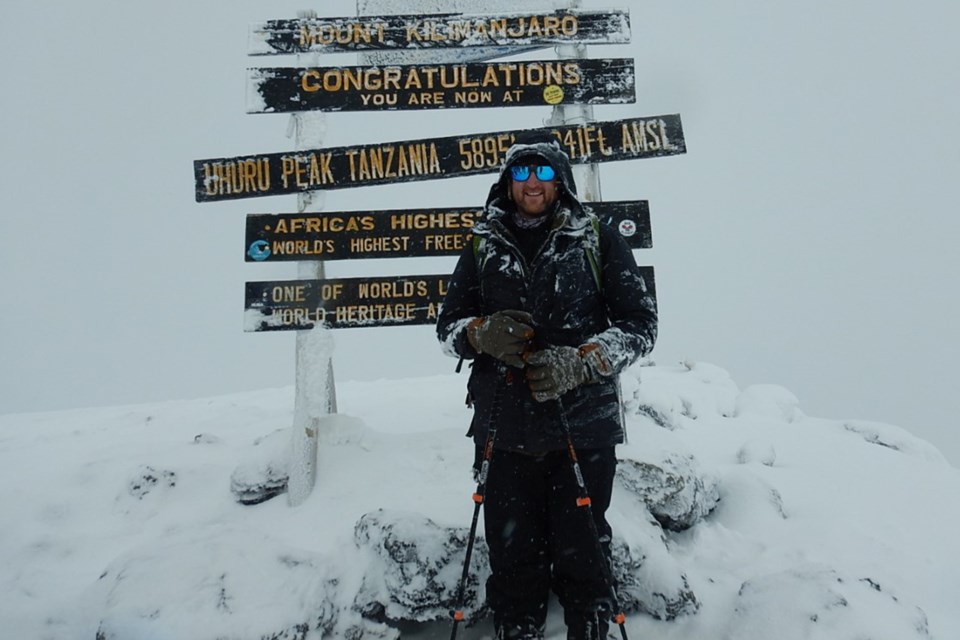MOUNTAIN VIEW COUNTY — A Water Valley man is preparing to climb Mount Aconcagua in Argentina, part of his goal to complete the Seven Summits challenge — climb the tallest peaks on the world’s seven continents.
Jeffery Bilow plans to scale Aconcagua in January.
It’s the second peak in his journey. Last October, Bilow climbed the first mountain in that challenge, Mount Kilimanjaro in Tanzania, Africa.
If all goes well, by the time it’s over, Bilow will also have climbed peaks in Alaska, Russia, Antarctica and southeast Asia — including Mount Everest, which at 8,846 metres will be his highest climb. He intends to leave that one for last in 2026.
The goal is for Bilow, 44, to reach the summit on each one of them before he turns 50.
Bilow got the idea to climb all these mountains after his wife passed away from cancer in 2016 at age 32.
“Just prior to that and going through that whole process of her being sick and taking care of her and all that, I realized life is short,” Bilow said during an interview.
“I always wanted to possibly climb mountains and explore and be on adventures like that.”
So in November, 2017 he began training for the Kilimanjaro climb.
Bilow trains in a variety of ways.
“I live back in Water Valley, so lots of time up and down hills and hiking and a lot of internal, like, weight work and elliptical and cross training; so lots of that,” he said.
He picked up lots of useful information by reading online forums.
Despite how dangerous and exhausting mountain climbing can be, Bilow doesn’t see his age as an issue.
“I don’t think there’s an ideal age,” he said. “I just think if you take care of yourself, you’re healthy, you have the drive and the ambition and the desire to do it, you can do it.
“It has a lot to do with your mind being focused on achieving that result of getting to the top and overcoming some of the obstacles your body tells your mind to not overcome; that’s a big part of it.”
When Bilow made the final push to the top of Kilimanjaro, conditions weren’t exactly ideal.
He was among a party of seven who made that final climb.
“We faced it in a blizzard,” he said. “You go from roughly 15,000 feet to the top, and you start that at around midnight.
“You do it in a blizzard, so your body’s telling you this is not a good idea, but your mind’s like, ‘no, I’m going to the top.’
“It’s supposed to normally take you six hours and it took us over eight because of the conditions.”
Fortunately as he climbed that night, there were no crevasses to deal with. But there were other issues.
“Obviously you’re at high altitude so there is a risk of altitude sickness, delirium, dizziness, you know, things like that. And a lot of people do face that,” he said.
Bilow was among a party of seven who attempted that final climb to the summit. Two had to give up their attempt.
Climbing these tall mountains is not cheap.
Bilow, the general manager of an agricultural equipment business in Olds, estimates summiting Kilimanjaro cost him about $8,000.
He figures it will cost between $8,000 and $10,000 to climb Aconcagua and “way more expensive” to summit Mount Vinson in Antarctica. He estimates it will cost about $70,000 (U.S.) to climb Mount Everest.
“You’ve got to save for it,” he said, conceding that might include selling his house.
Bilow said so far, his penchant for climbing tall mountains hasn’t impacted his insurance premiums.
“As long as you don’t get injured, your premiums never go up,” he said.
“The biggest thing though is just, if you prepare yourself, you have the right attitude and the right nutrition and things like that, you stay healthy.”
But despite that optimism, Bilow is aware of what the mountain can throw at climbers.
“I think the scary part is there’s a lot of things you can’t expect,” he said.
“You can’t necessarily expect how altitude sickness will affect you. Some of the best climbers in the world have climbed Everest, then gone to other mountains and have had altitude sickness at much lower elevations.
“Plus, the human body you know, from time to time decides to not act like you think it’s going to.”
One big issue is people who aren’t as ready for climbing as they think they are. Bilow said that’s especially a problem on very tall mountains like Everest.
“It creates this lineup of traffic, right? And if somebody falls, it takes out 15 people, 20 people at one time.”
Bilow is hopeful by the time he gets to Everest, the Nepalese government will be doing a better job of managing that issue.
Another problem is climbers leaving lots of garbage – on Mount Everest and other peaks.
Bilow said he makes sure he brings back most — if not all — of what he takes with him on his climbs. He’d like to see others do that.



